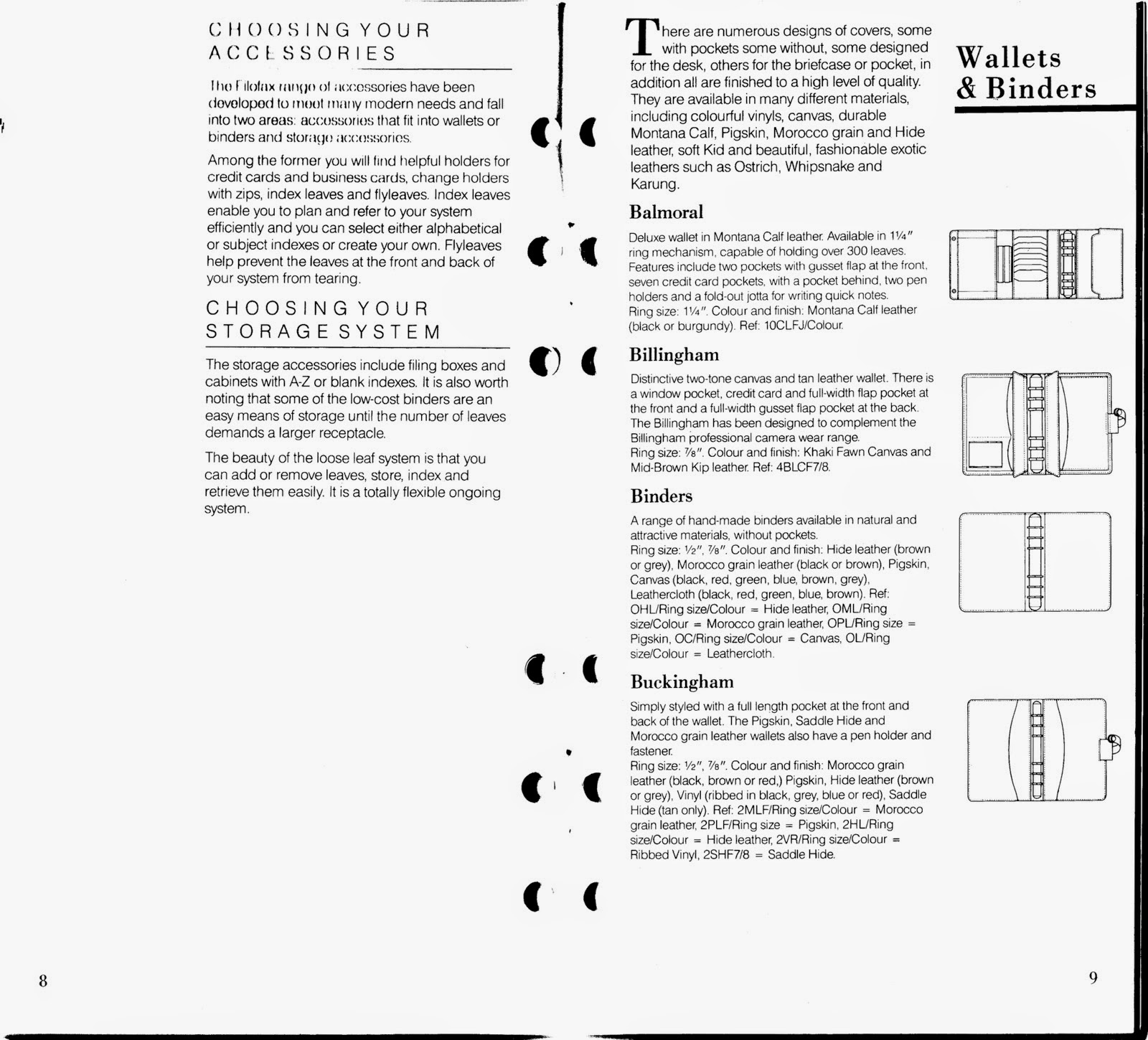Today we go back to the late 1980's, we haven't as yet managed to confirm the exact date of this particular catalogue, but I have a vague recollection that it is 1987 because I had a copy of this one myself back then, also one of the pages shows a Deskfax with a 1987 calendar page.
Thank you to Jené for supplying the scans of this catalogue.
The content of this post is the intellectual property of Filofax Group Ltd. The scans are reproduced here with the full permission of Filofax Group Ltd.
And there are higher resolution versions of all the pages here.
As always the pictorial content of this post is the intellectual property of Filofax Group Ltd. The scans are reproduced here with the full permission of Filofax Group Ltd. for educational and non-commercial usage.
























Thanks Steve and Jené for sharing this old catalog...
ReplyDeleteMy just be my lack of familiarity, but what struck me in looking through the pages is what a wide variety of inserts there were then. Seems like there's a lot less now....
For example, pages for Church, Computers, Investments, Military and Marine, Publishing, etc.....
Very interesting....
Mark
It was the huge range of leaves that caused Filofax major headaches by 1989. Everything was sold through stockists and few of them were prepared to carry - and display - the huge range of inserts - many of which sold in tiny numbers. Customers (these days referred to by Filofax - in a somewhat derogatory way - as "consumers") couldn't order directly and it was a hassle for stockists to have to obtain the more obscure packs, which were also costly for Filofax to produce in small quantities.
DeleteIt may be argued that by decimating the range of leaves, the main selling point - huge flexibility - was ruined. These days, with overnight direct mail order, it would be much easier for them to reintroduce much of the range, but they are just not interested.
Thanks for sharing this.
ReplyDeleteYes I would agree with 1987 as the date. In 1986 the Gloucester was still available, but it's not listed. And the fact that several of the sport leaves are marked as new to the range ties up with a 1987 product list I have seen where they appeared for the first time. It all seems to match.
The pictures show that earlier versions of Balmoral were a mirror image of the configuration later on. The jotta is on the left and the rings on the right here, but these had switched round by 1989.
ReplyDeleteI'm intrigued with the 'Deskfax' that was a standard six-rings but which was twice the width of a standard page. I have never seen one of those, anywhere! When did Filofax start using the name 'Deskfax' for the 9-ring binder?
ReplyDeleteWhat was the 6-ring, double-width deskfax like to use?
Yes Amanda. Deskfax got off to a false start in 1986 as a double width personal size. That was phased out, and replaced in 1989 by the nine ring Deskfax that we are more familiar with. It was then renamed to "Professional" format soon afterwards, but later on reverted to the name Deskfax.
DeleteI think the 6 ring version would have been handy for working with the double width leaves available then. In fact, Lefax used to make a series of basic binders that would fit double, triple and quadruple sizes unfolded.
I have seen the old, 6 ring Deskfax size used as visitor books, which works quite well.
In Japan there is a size that's the height of personal and the width of A5, which seems quite a good compromise between those two. The old, 6 ring Deskfax was a bit wider, but along the same principle.
To my mind, a double-width six-ring binder would be more useful than the B5 9-ring version, especially if you could fold the pages to put in a normal personal binder, but maybe that's just me! I could imagine using the double-width to be able to see a weekly and/or monthly overview, with normal size daily pages in the middle - thereby seeing all three views at once without taking up as much space as the B5 version (or in fact, an A5). I wonder why they stopped making them so quickly? Presumably because either the bottom fell out of the filofax market and/or because they didn't sell well (even if the rest of the range was holding up).
DeleteI agree that the double width size would be more useful, but I think it can't have sold very well. Another reason for changing to the 9 ring may have been the subsequent idea of offering three sizes - 4 ring pocket, 6 ring personal and 9 ring professional - with upwards interchangeability of leaves, which was a selling point in 1989.
DeleteWhat an amazing trip down memory lane. I had the Sale & Marketing inserts along with the Time Out inserts in my very first Filofax.
ReplyDeleteSteve, thanks for posting this. I knew FIlofax had a huge range of inserts back then but it was still a surprise, especially the filmfax ones.
ReplyDeleteFilofax could make these inserts in a "pay to download format". I'd certainly be interested in many of them.
ReplyDeleteI so agree with this. I'm gutted that they discontinued the addressbook and webpage print software. Surely it wouldn't have hurt to keep that up and generate a few quid. Not everyone wants to make their own. I wish they'd reissue the birdwatching list.
DeleteWhat they need to do is a Filofax shop where they host various inserts for download, something similar to the iTunes app store.
ReplyDeleteWhat they need to do is a Filofax shop where they host various inserts for download, something similar to the iTunes app store.
ReplyDeleteGreat idea......but pretty 'hi-tech' for ol' Filofax?...........
Delete;-)
Mark